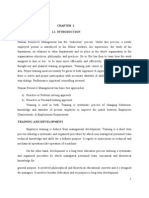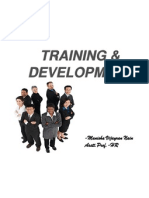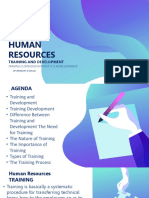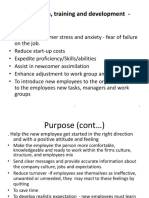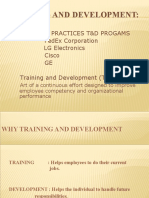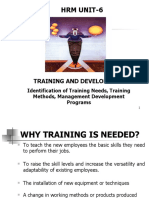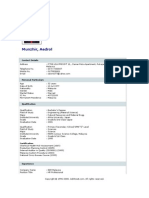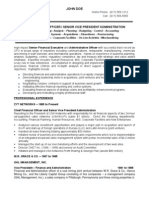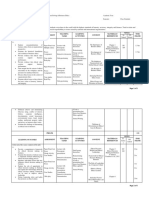CHAPTER FIVE
TRAINING AND DEVELOPING EMPLOYEE
Introduction
Once organizations have selected and employed competent people, they need to help them
ensure that their job skills and knowledge are kept current. Organizations do this through
training and development programs. Having qualified and well trained personnel to perform
various jobs is a very basic necessity for any organization. Training becomes necessary because
of changing technology, up gradation of skills and knowledge of the workers, the need to
increase the productivity of the workers, etc., so as to retain the competitive edge.
5.1. MEANING AND DEFINITION
Training and development can be defined as planned efforts by organizations to increase
employees’ knowledge, skills and abilities.
Development is the systematic process of education, training and growing by which a person
learns and applies information, knowledge, skills, attitudes and perceptions
• Training is a process of learning a sequence of programmed behavior, which helps the
trainees in improving their job performance and better apply their knowledge.
• Development covers not only performance improvement activities but also those which
enhance personality, gain better attitudes, values and behavior.
• The scope of development is wider than training.
5.2. TRAINING OBJECTIVES
To orient new employees: while schools and training institutions provide general education
in many skills new employees require additional training to acquaint them with specific
situation of the organization and the job.
To improve performance: training will help to improve performance by increasing
productivity, improving quality, reducing turnover, reducing labor cost, etc.
To maintain current performance: sometimes individuals holding a position or doing a job
may get obsolete so train these employees will help to maintain current performance.
To make the workers perfect in their work, so as to increase their productivity.
Proper training would help the worker in producing quality products.
1
�5.3. General Benefits from Employee Training and Development
Superiors may have several reasons to conduct training and development among employees. This
includes:
Better performance of employees: The systematic training leads to better performance
of employees in their present job because their knowledge and skill for doing the job will
improve.
Boost employee morale: Training provides a big boost to the morale of the employees.
If an employee is satisfied on his/her job, he/she tends to have high morale. A trained
employee performs his work with knowledge, skill, and pride and derives job
satisfaction.
Reduction in supervision: Training brings about a high degree of self discipline and self
supervision among employees. Management control and supervision with trained
employees become easy and smooth.
Reduction in operational problems: Training of both supervisors and operating
employees can help to reduce operational problems like turnover, absenteeism, accidents,
grievances, low morale etc.
Trained supervisors are able to establish better relationship with their subordinates and
seek employee cooperation in the achievement of organizations objectives.
Fulfill manpower needs of the organization: The best way to overcome recurring
problems of recruiting skilled workers is to establish apprentice training program.
Thus, training helps in identifying talented and promising men for different types of
skilled jobs in the organization.
Beneficial to employees: With the availability of trained personnel in the organization, it
can have stability and flexibility.
It increases stability because there is a reservoir of trained replacement.
It is flexible because trained employees possess multiple skills that can be transferred to
other jobs as the situation demands.
Increases organizational stability and flexibility: Training is beneficial to employees
because organizational knowledge and skills, increases their market value and they have
better chances for promotion and ability to accept higher responsibilities.
2
�5.4. Employee Training and Development Process
The steps in the employee training and development processes are:
1. Identifying the training needs
• All training programs are created to meet the various needs of the organization.
• To properly identify the needs of the organization it is very important to conduct a
thorough organizational analysis, operations analysis, and analysis of the manpower it
possesses.
• Organizational analysis basically involves analysis of the organizational goals and the
resources allocated to achieve these goals.
• Operations analysis focuses on the way in which a job or task is to be done in an
effective way.
• Manpower analysis tries to find out the qualities, knowledge, attitudes, etc., of the
present workers of the organization.
2. . Getting ready for the job
• In this stage the human resource managers or the trainer decide who is to be trained,
the duration of the training program, what kind of training material to be collected,
and other kinds of preparation for the program.
3. Preparation of the learner
• In this step the learner is told about the importance of the training program, its
contents, and its contribution to improved performance of the individual as well as the
organization.
• A learner is generally nervous before any training program and it is the duty of the
trainer to psychologically put him/her at ease and generate interest in the program
4. Presentation of Operations and Knowledge
• It is the most important step in the training program. It involves the actual transmission
of knowledge or operations through lectures, illustration, discussions,
demonstrations,etc.
• Usage of audio visual teaching aids enriches the teaching-learning process of these
programs.
5. Performance Try Out
3
� • In this step the trainees are tested and the effectiveness of the training program is
found out.
• Performance try out is generally carried out
– By asking the trainees undertake written or oral tests to ascertain their subject or
technical knowledge,
– by observing the performance of the trainees on the job itself,
– by taking the evaluation of the trainees about the program,
– by conducting structured interviews and by making the trainees fill up
questionnaires,
– by taking the feedback of the top managers about the program and by comparing the
actual performance of the trainees before and after training.
6. Feed back
• In this last stage, the trainees are left on their own and checked frequently to see how
far they follow the new techniques learnt in the training program and its impact on
their productivity.
5.5. Training Methods
Training methods are important for delivery of training. They can be:
1. On-the-job Training Methods
2. Off-the-job Training Methods
1. On-the-job training methods
• In this type of training, an employee is put on the work floor directly and is assigned
to a superior or to an experienced worker who teaches/guides him in how to do the
work practically.
• These methods are a part of the everyday job activity of the organization. This is the
most common method of training because it is practical oriented, less expensive and
the focus is on the job.
The methods available for on-the-job training are:
A. Apprenticeship Training
B. Internship Training
C. Job Instruction Training
A. Apprenticeship Training
4
� Employees learn by working with those already skilled in their jobs. The examples are
plumbers, electricians, accountants.
The duration for apprenticeship varies from job to job-generally from two to five
years.
Trainees are allowed to perform sophisticated tasks as their skills and experience
increase. A master worker guides the trainee.
B. Internship Training
• It is provided to skilled and technical personnel. The goal is to combine practical
experience with classroom-oriented theoretical knowledge.
• The trainee is interned in organizations for a specified period and works as an
employee. Students of technical subjects generally undergo internship training.
C. Job Instruction Training
• It is a systematic approach to on-the-job training to teach new task. Job Instruction
Training is designed for supervisors to train operatives.
• Job Instruction Training is directly related to specific work situation. It is easy to
deliver. It is an effective low cost training solution.
• It is received directly on the job and consists of four steps:
– Preparation: The trainees are told about the job. They are put at ease. Their
desire to learn is aroused.
– Presentation: The trainees are given instruction by telling, showing,
illustrating and explaining about new knowledge and skills.
– Practice: The trainees actually perform the job to demonstrate their
understanding. Errors are corrected. Practice is continued.
– Follow-up: The trainee is placed in the job on his own. A resource person is
designated for providing needed assistance.
Advantage of On-the-job training methods
• It is widely used, because it is economic and convenient and no special facilities,
equipment and training places are required
• The employee produces and contributes to the organizational objective and at the
same time s/he learns job rotation and job instruction methods which are few of the
techniques used in on the job training.
5
� • It is convenient for small number of trainees.
Some of its disadvantages are: -
• it creates disinterest of employees, employees have dual responsibility, &
• it is not convenient for large number of employees.
2. Off-the-job training methods
This type of training is given to the trainees away from the work floor and is not the
everyday activity of an organization.
The training takes place outside the work situation. It is mostly classroom-based. The
trainees focus on learning experience. They removed from the stresses and demands
of workplace.
The methods used for off-the-job training are:
A. Lecture/ conference
B. Simulation exercises
C. Programmed Instruction
A. Lecture/Conference:
• It is based on talking and showing. It is oral communication of specific information by
instructor to trainees.
• It is teacher-centered "training by telling". The use of audio-visual aids like films,
video, television, overhead, projector makes the formal presentation interesting.
• The training can be conducted on-site or elsewhere depending on the availability of
facilities.
• A conference is a group meeting based on trainee participation guided by a leader.
Subjects of common interest are discussed in conferences.
B. Simulation Exercises
• Simulation is abstraction of real working conditions in the lab or classroom. The
trainee is placed in an artificial environment that closely resembles actual working
conditions. Or this method tries to give the trainees a chance of getting trained in a
situation which is as close to the original work situation as possible.
• Computer modeling is an example of simulation. Airlines use simulation exercises to
train pilots.
6
� • Simulation exercises avoid costly errors and injuries that may result during training on
the job.
The techniques of simulation can be:
• Computer modeling: They simulate the real world situation through computer
modeling. Trainees analyze the situation for learning purposes.
• Vestibule Training: Trainees learn their jobs on the equipment they will be using on
the job. The training is delivered away from the actual work place.
– In this method identical machines and equipment, which are used on the work
floor, are installed in a training center and also an effort is made to duplicate
work atmosphere found on the actual work floor.
C. Programmed Instruction
• They can be in the form of programmed text or manuals. They condense information
to be learned into organized and logical sequences.
• Trainees are required to provide feedback on their learning progress.
• Training time is reduced and the trainee learns at his/her own pace but the training and
development content is limited in programmed instruction.
Advantages and disadvantages of off the job training
Advantages
• It creates interest of employees because employees are removed from their routine
activities and are moved to new environment.
• It is convenient for large number of employees. (trainees)
Disadvantages
• It is expensive- there are costs for trainers, facilities, and also the employee does not
contribute during the training.
• There is a problem of transfer of knowledge from the training situation to the actual
situation of the job.
5.2. CAREER DEVELOPMENT
It is a known fact that most professionals leave an organization due to lack of career growth.
Active career development initiatives by a company are a key retention tool to keep the best
talent within its field. It is one of the greatest motivators to keep an employee happy and
engaged. But does career planning and development of employees actually make a difference to
7
�the productivity of a worker? Most organizations think so, and consider it a part of their critical
human resource strategy. From the employees’ point of view career development initiatives
gives them a clear focus about their career track, the blind spots that they have to overcome and
the final goal to be reached. This focused approach works to their advantage from their everyday
work to long-term aspirations.
The impact of career development/ succession planning programmers can be seen through the
productivity indicator, engagement surveys and reduction in attrition rate. It is in fact a win-win
situation for all. “The typical employee views a career development programme as a path to
upward mobility, the manager sees it as a retention and motivational tool, and the top
management view it as a tool for succession planning,”. These career development efforts bring
into focus high potential candidates who can be groomed for greater responsibilities in the future.
Career development programmes enable a deeper focus on an employee’s aims and aspirations—
from identification of the handicaps being faced by an employee in accomplishing his goals to
the solutions in terms of re-skilling or reassignment. This focus acts as the significant motivator
for an employee to excel and exceed the targets. “It facilitates powerful personal and
professional development. As per the motivational theories, achievement orientation, growth and
development are the basic human needs.
An organization focused on developing the career path of its employees boosts the morale and
ultimately the productivity of its staff. Besides helping employees get equipped with relevant
skills and knowledge, it also facilitates the organization’s objective of showing a well-
articulated, growth oriented yet flexible career path to its employees. A strong sense of direction
coupled with responsibility, boosts motivational levels and hence performance.







